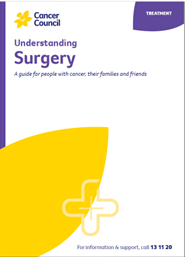- Home
- About Cancer
- Cancer treatment
- Surgery
- The day of the surgery
- Surgical wound
Surgical wound
Your surgeon will close up the wound (incision) created during the surgery. Their approach will depend on the part of your body affected and the kind of surgery you had (e.g. open or keyhole surgery).
Common ways to close a surgical wound include:
- sutures or stitches – sewing the wound closed using a strong, threadlike material that can dissolve or will be removed at a later date (see Follow-up appointments)
- staples – small metal clips that will be removed by your doctor once the wound has healed
- glue – clear liquid or paste that dissolves over time; used to seal minor wounds (up to 5 cm) or applied on top of sutures
- adhesive strips – pieces of tape placed across the wound to hold the edges together; may be used with sutures.
Wound coverings (dressings)
The wound will usually be covered with a surgical dressing to keep it dry and clean. This may be a waterproof adhesive dressing or a bandage. The dressing will be changed as needed. If you have surgery as an inpatient, the nurses will look at the wound to see if it’s healing and to check for bleeding or signs of infection. When you have a shower, if the dressing is not waterproof it may need to be covered or taken off and reapplied afterwards.
The wound may feel itchy or irritated after surgery. Tell the nurses if this happens – it could be a sign it’s healing, but it may also be a problem, such as an allergic reaction to adhesive tape.
Before you leave hospital, the nurses will give you instructions about how to care for your wound and dressing.
After the wide local excision, the wound looked red and was sore, but this improved.
Pete
→ READ MORE: Complications during surgery
Podcast: Coping with a cancer diagnosis
Listen to more of our podcast for people affected by cancer
More resources
Prof Elisabeth Elder, Specialist Breast Surgeon, Westmead Breast Cancer Institute and University of Sydney, NSW; Chanelle Curnuck, Dietitian – Dietetics and Nutrition, Sir Charles Gairdner Osborne Park Health Care Group, WA; Department of Anaesthetics, Perioperative Medicine and Pain Medicine, Peter MacCallum Cancer Centre, VIC; Jessica Feeney, Nurse Unit Manager, Breast, Endocrine and Gynaecology, Royal Adelaide Hospital, SA; A/Prof Richard Gallagher, Head and Neck Surgeon, Director of Cancer Services and Head and Neck Cancer Services, St Vincent’s Health Network, NSW; John Leung, Consumer; Rohan Miegel, Senior Physiotherapist – Cancer Care, Flinders Medical Centre, SA; A/Prof Nicholas O’Rourke, University of Queensland and Head of Hepatobiliary Surgery, Royal Brisbane Hospital, QLD; Lucy Pollerd, Social Worker, Peter MacCallum Cancer Centre, VIC; Suzanne Ryan, Clinical Nurse Consultant, Department of General Surgery, Sunshine Coast University Hospital, QLD; Rebecca Yeoh, 13 11 20 Consultant, Cancer Council Queensland.
View the Cancer Council NSW editorial policy.
View all publications or call 13 11 20 for free printed copies.
Need to talk?
Support services
Coping with cancer?
Ask a health professional or someone who’s been there, or find a support group or forum
Looking for transport, accommodation or home help?
Practical advice and support during and after treatment
Cancer information
Dealing with the diagnosis
Common reactions to a cancer diagnosis and how to find hope
Other cancer treatments
Learn about the other cancer treatments that are used to treat cancer

